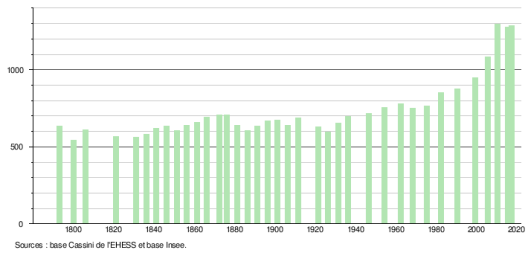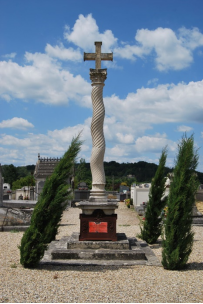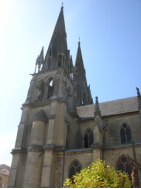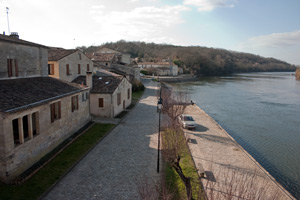Branne, Gironde, Nouvelle-Aquitaine 作者: 来源: 发布时间:2021-06-09
I.Population and Area
Total Area: 2, 14 km2 (0.83 sq mi)
Population in 2017: 1288
Population Density: 534 /km2 (1552 /sq mi)

Histogram of demographic change
II.Natural Geography (environment and resources)
Location: the town of Branne is located in the natural region of Entre-deux-Mers, on the left bank of the Dordogne, on the departmental road 936 between Castillon-la-Bataille and Bordeaux.
Hydrography: attached to the district of the Adour-Garonne watershed, Branne is more precisely located on the territory, downstream of the Cère, of the watershed of the Dordogne, on the left bank of the latter which separates it, to the north, from the commune of Saint-Sulpice-de-Faleyrens. Two other rivers cross it to flow into the Dordogne at the level of the town, the Goths stream, a small stream of 2 km which separates it from Cabara to the east, and, on the edge of Grézillac to the west, the Lyssandre, a 5km-long stream that originates in Guillac, runs along Lugaignac and irrigates Grézillac before reaching Branne in the southwest.

III.Economy
Unemployment rate (%): 12.4 (2017)
Average employment income (€):1 800 net per month (216 00 net per year)(2018)
Sector of activity | Number of companies | Share of companies |
Rental and operation of own or leased real estate | 50 | 20.6% |
Other human health activities | 20 | 8.2% |
Permanent crops | 10 | 4.1% |
Finishing work | 10 | 4.1% |
Creative, artistic and performing activities | 9 | 3.7% |
Evolution of average monthly net wages
Sources : http://www.journaldunet.com/business/salaire/branne/ville-33071
http://www.linternaute.com/ville/branne/ville-33071
IV.Industrial Characterisitics
Sectors of activity most represented in Branne
The table below lists the five sectors of activity with the most companies in Branne during the period from to as well as the share of each sector on the total number of companies in the municipality.
The companies that generate the most turnover in Branne
The list displayed below presents the companies based in Branne and which report the highest 2018 turnover in the municipality.
1)Dominique Morgant
2)Arilla
Dominique Morgant
DOMINIQUE MORGANT, a single-member SARL with a capital of € 1,000, started its activity in January 2010.
Dominique Morgant is located in Branne near Libourne in the Gironde department (33) and is specialized in the bathroom sector, as well as all interior design and insulation work for more than 10 years. .
Dominique Morgant offers its services for the realization of all your bathroom creation work from A to Z, from the installation of the taps to the installation of tiles and earthenware, as well as all your renovations.
She also performs interior fittings, such as the installation of kitchens, floating floors, painting, as well as all your plastering and insulation work.
In addition, it works in the fields of sanitation and masonry.
Arilla
ARILLA, SARL with a capital of € 8,000, began its activity in November 1992.
We market soil restructuring agents based on polyuronides and polysaccharides, obtained by hydrolysis of seaweed harvested in the open sea: TILCO natural products, to increase soil fertility and promote the harmonious development of plants (see www.tilco site. Fr)
Often we have had to inject our products into the ground with a bio-injector (hydraulic root decompactor) to save trees whose roots had been cut which disturbed and which lifted asphalt mixes, coverings, paving.
(see Bio-injection sheet)
Also, to avoid such damage and not to deprive ourselves of planting species with an aggressive root system anyway, we offer a technique that has been used for more than twenty years in the United States and which has already won over many Green Space services in France and Roads: installation of DeepRoot® deep root guide panels. We also market other anti-root dams to protect urban infrastructure from root invasion and attack from bamboo rhizomes, walls, barriers, RootBlock® and RootControl® membranes, ArborGard tree trunk protection sleeves ®, TreeProtect ®, Gefa® tree root ball anchoring systems and AirMax® and AquaMax® drains for their aeration and irrigation.
Also, the town is located in the geographical production area of Entre-Deux-Mers, a controlled designation of origin for dry white wines from the vineyard of the same name. The whole region also produces reds, clairets, rosés, dry whites, sweet or sparkling under the names bordeaux and bordeaux-superieur.
Sources: http://entreprises.lefigaro.fr/branne/ville-33071
https://www.verif.com/societe/ARILLA-389036633/
http://www.arilla.fr/
https://www.verif.com/societe/DOMINIQUE-MORGANT-519059554/
http://www.morgant-salle-de-bain-libourne.fr/
V.Attractions
1.Branne cemetery cross

The Branne cemetery cross is a hosannière cross located in the center of the new communal cemetery of Branne in the Gironde.
It is from the fifteenth century that the cemetery crosses appear. When they are placed in the center of a cemetery, they are said to be hosanna crosses (the Hosanna prayer is sung there during the blessing of the branches). Most often they are built by master masons rather than real sculptors. They correspond to gifts from rich lords. The cemetery crosses highlighted the patron saint of the parish, since a representation of this saint usually occupied one side of the summit cross.
The Branne cross dates from the 17th century. It is perhaps a gift from the lords of Saint-Jean-de-Blaignac. Formerly the cross was next to the Romanesque church in the old cemetery.
It takes the form of a fluted torso column that emerges from a crown of foliage on a molded base of three tori and two scoties. The column is crowned with a Corinthian-style capital which bears a cross pattée. The arms of the cross are decorated with discs on the west side and squares on the east side.
The cross has been classified as a historical monument since July 18, 1973.
2.St. Stephen's Church

Built on the site of a small 11th century Romanesque church, the Church of Saint Etienne de Branne is a neo-Gothic building built between 1859 and 1878.
Come and discover this monument symbolizing the rise of the city and the will of a man.
Open from Wednesday January 1, 2020 to Thursday December 31, 2020
Languages spoken: English
Visiting conditions: Self-guided tour - Guided tour by appointment only
Equipment: Picnic area - Catering
3.Dordogne

The Dordogne is a French watercourse that begins at Puy de Sancy (1,885 m), the highest point of the Massif Central, in the chain of the Dore mountains. It merges with the Garonne to form the Gironde estuary which opens onto the Atlantic Ocean after having crossed the Dordogne department and part of the Gironde department, in the Aquitaine Basin.
The Dordogne valley is classified as a country of art and history in its part of Lot. On July 11, 2012, its entire watershed was classified as a biosphere reserve by UNESCO.
The Dordogne merges with the Garonne, which forms the Gironde estuary. For this reason it is described as a river in dictionaries and encyclopedias as well as by the Pike perch. However, some regional organizations qualify it as a river, considering that the Gironde is an estuary common to the Garonne and the Dordogne, which would make it the fifth longest river in metropolitan France.
The divergence of denomination (although its hydrological characteristics are not in question) refers to the problem of the definition of an estuary: is the Gironde a common estuary between the Dordogne and the Garonne, or is the Dordogne a tributary of the Garonne river? If the choice remains trivial for the name of the watercourse, it nevertheless implies a different hierarchy of the watershed (s).
A notable argument makes the Dordogne a river, it is the presence of a powerful tidal bore, resulting, during high tides, from the seasonal penetration of the maritime domain into the watercourse. The tidal bore of the Dordogne is well known and is an attraction. For the Dordogne, the wave goes up to Fronsac on the outskirts of Libourne, about thirty kilometers inland. The wave is particularly powerful at the port of Saint-Pardon in the town of Vayres. The maritime influence on the Dordogne is not limited to the tidal bore alone: the level of the watercourse is subject to the action of the tides as far as Castillon-la-Bataille, even going as far as Pessac-sur-Dordogne during spring tides. These daily ebbs and flows can easily be visualized on the record of the water heights measured at the Libourne hydrological station.
The Dordogne could very well not have gone beyond its confluence with the Chavanon [not clear], at the level of the Corrézienne commune of Confolent-Port-Dieu, which is located at the beginning of the water reservoir of the Bort-les-dam. Organs. The Chavanon, sometimes referred to as Chavanou, joins the bed of the Dordogne after a 54 km crucible. The Dordogne, at this confluence, has only traveled 39, or about fifteen less, but, conversely, it discharges a greater volume of water. The Chavanon is also called Ramade in its upper course.
Sources :http://wcf.tourinsoft.com/syndication/aquitaine/d9cc70a0-b1d5-4e72-9996-0d844fbf53b5/object/PCUAQU033V508TMR/BRANNE-Eglise-Saint-Etienne-de-Branne
VI.History
"The canton of Branne sits on one of the most picturesque set of low hills and gently sloping valleys, watered by small streams which flow slowly into the Dordogne river".
Extract from the work of J. Mongélous "History of the canton of Branne"
His origin:
Many meanings are given to the name of Branne du GAULOIS (hill), from Celtic BRANDA (heather), to Latin BRANO DUNUM without however satisfying us.
Branne certainly owes its origin to the very configuration of the soil. The Dordogne brought its first inhabitants there, descended from the High Country because Neolithic sites have been identified. Its location is on the only notch of the hill, between Montremblant and the hill of Pey du Prat.
Its geographical location:
Small town of 254 ha nestled on the banks of the Dordogne, a stone's throw from Saint Emilion, Branne is part of the Gironde department and the Libourne district. It is also the capital of the canton.
Regarding its river "La Dordogne", this was an important axis for trade (wines, wood, cereals).
The river trade of Branne developed in the eighteenth century because the merchants and craftsmen were there for the most part with boatmen, fishermen, traders, carpenters ...
Our river popularized by the film "La Rivière Espérance" is open to view. Formerly the barges loaded with barrels, cereals, wood or stones sailed on the Dordogne; from this activity we can still admire the quays today.
His architecture:
Branne, in addition to all its services also has its architectural features:
- "The Church of Saint Etienne" which was built on the initiative of Chanoine Lapeyre. It was built from 1859 to 1878. The interior is composed of a nave with four bays covered with arches and two aisles.
- "La Halle" which is located in the heart of the city, was at the time the vital center of Branne where the inhabitants of the neighboring towns came to sell and buy food, objects and various goods. It appeared in the land register of 1672 and it benefited from the letters patent of Louis XV in 1770.
- "An original cross" is composed of a twisted and fluted shaft as well as a Corinthian capital from the 17th century. It is listed in the inventory of Buildings of France in 1973 and is in the cemetery.
The azure background of the coat of arms supporting the 3 white fleur-de-lis represents the arms of French royalty.
Branne is a small town nestled on the banks of the Dordogne, it is the link between the vineyards of Saint-Emilion and that of Entre-Deux-Mers.
Branne owes its development to the river trade which developed in the 17th century with the navigation of the beautiful barges on the Dordogne.
The nautical stopover shows that navigation continues: river tourism has replaced trade. The bridge built by Eiffel in 1911 spans the Dordogne.
In the heart of the city, the market has been on the land register since 1672.
Branne is part of the Pays du Libournais, and is located at the gateway to Entre-deux-Mers.
Due to its essential strategic position, the history of the city is marked by the passage of the most illustrious characters and their armies: Louis XIII in 1615, Cardinal de Mazarin in 1659.
The bridge over the Garonne at Branne has existed since the 12th century. The bridge is then tolled and brings back a lot of money to the lords of Branne!
The port of Branne has been very active since the Middle Ages and will remain so until the 19th century. The intense river activity is animated by the transport of freestone from the quarries of Daignac and Lugaignac. After the stone trade, it is the wine trade that monopolizes the port of Branne. The transport of gravel and sand adds to the heavy traffic of the port
This flourishing trade creates jobs in the city and more particularly on the quays where many artisans come to settle (wheelwrights, fishermen, cabaret-makers, tail-makers).
The quays will be redone in the 19th century as well as the market hall, the town hall, the schools, the new church. Major road works were also undertaken and the cemetery was moved.
The city became head of the Canton after the Revolution, and was occupied by the Germans during World War II.
Sources: https://www.mairie-branne.fr/tourisme-et-culture/histoire-et-patrimoine/historique
http://www.caruso33.net/ot-branne.php
VII.Other information
The Community of Communes acts for culture in its territory by setting up several media libraries operating in a network. Accessible to all, there are books, magazines, CDs, DVDs, comics, manga, albums for young and old, but also computers with Internet access and computer tools. Whether it is to take the time to enjoy friendly places, to exchange with other people, to borrow documents or to attend events, come and indulge your curiosity. Subscription is free for residents of the CDC Castillon-Pujols as well as for those under 18. Annual membership for residents outside the CDC is € 10 / year
IT'S ALSO BACK TO THE MEDIATHÈQUE DE BRANNE ET NAUJAN-ET-POSTIAC!
From August 28, 2020
Dear users, Dear users,
It's back to school in our media libraries too!
From Tuesday 01 September, we welcome you again!
Our team has made every effort to adapt the measures indicated by the health authorities to our media libraries and thus strengthen your safety and that of our employees and protect everyone's health.
We can't wait to see you again.
Until then take care of yourself, and have a good start to everyone!
Branne multimedia library
The opening hours of the media library:
- Tuesday: 3 p.m.-6.30 p.m.
- Wednesday: 9:30 am-4:30pm non-stop
- Friday: 3 p.m.-6.30 p.m.
- Saturday: 9:30 am-4:30pm non-stop
Access to the media library will be limited to a maximum of 20 people simultaneously and 30 minutes on site in case of crowds.
Naujan-et-Postiac media library
The opening hours of the media library:
- Wednesday: 3:00 p.m.-6: 30 p.m.
- Friday: 9:30 am-12:30pm
Sources : http://www.mediathequesdubrannais.fr/index
https://www.castillonpujols.fr/culture-et-sports/m%C3%A9diath%C3%A8ques/
VIII.Contact information
Branne town hall address :
Branne town hall
2 place du 11-Novembre
33420 Branne
Opening Hours of the town hall:
Wednesday: from 8 a.m. to 5 p.m.
Thursday: from 8 a.m. to 1 p.m.
Monday to Tuesday: from 8 a.m. to 1 p.m.
Friday: 8 a.m. to 6 p.m.
Mayor : Marie-Christine Faure (Mandate : 2014-2020)
Mail: maire-de-branne@wanadoo.fr
Phone number: 05 57 84 52 33
Fax: 05 57 74 90 82
Website : http://www.mairie-branne.fr
Sources : http://www.cartesfrance.fr/carte-france-ville/33071_Branne.html#mairie
